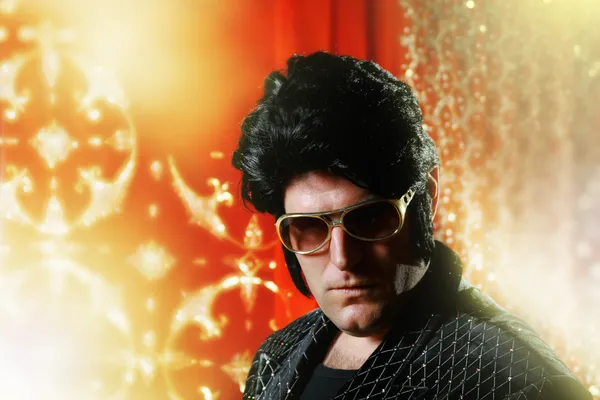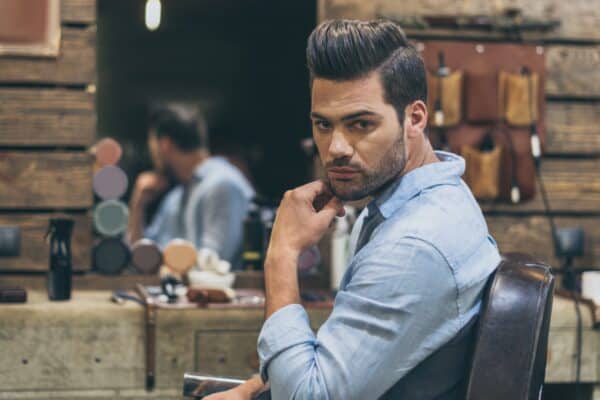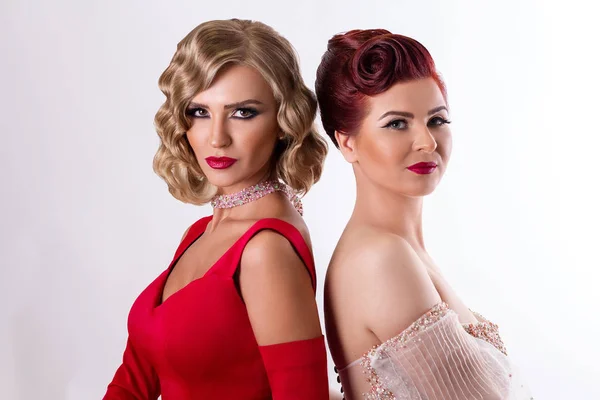When I think of the 1950s, I imagine people sporting Victory Rolls, polka dots, quiffs, and well-groomed pompadours.
The pompadour might sound like a strange name, but it was a popular hairstyle trend in the 20th century. It is known for its upward and backward hair sweep that creates a “mound” on top of the head.
The hairstyle has a long history dating back to 18th-century France.
But then, who made it famous in the 1950s?
Was it hard to style, and did it convey any message to society? Does anyone still wear a pompadour today?
Let’s take a trip back in time and answer all these questions!

Key Takeaway
- The pompadour hairstyle originated in 18th-century France, was named after Madame de Pompadour, and involved voluminous curls and waves as a symbol of elegance.
- In the 1950s, Elvis Presley and other rock n’ roll musicians popularized the slicked-back men’s pompadour and greaser styles as part of their rebellious look.
- Key pompadour elements involve height, volume, high fade contrasts on the sides and back, styling direction, and front wave shapes – suited to various hair types.
- Though vintage styles vary, pompadours remain popular among celebrities and others looking to achieve a daring, glamorous aesthetic with a nod to iconic 1950s musical rebels.
Madame de Pompadour and the Origins in the 18th Century
So, who made pompadour famous throughout history?
The hairstyle is named after Madame de Pompadour – a woman of great influence, power, and elegance.
As the mistress of King Louis XV of France, she held numerous roles, including diplomat, politician, and the king’s advisor. She also patronized the arts, supporting artists, writers, and musicians.
Madame de Pompadour became famous for her signature towering hairstyles, usually involving voluminous curls and waves. It was a symbol of elegance, sophistication, and luxury, and it was popular among women of French nobility.
The Rise of Men’s Pompadour in the 1950s

Let’s talk about how men’s pompadour slowly but surely witnessed a huge rise in fame during the 1950s.
Elvis Presley and the Pompadour
Two centuries later, the King of Rock and Roll, Elvis Presley, set stages on fire with his performances. But that’s not all – his daring hairstyles and clothing were just as legendary.
His signature slick hairstyle, paired with a pompadour, brought an old-fashioned look into vogue.
The hairstyle made the icon look like he was wearing a crown. It was one of his strongest trademarks!
Then, the pompadour gained popularity among celebrities, actors, musicians, and other influencers. It wasn’t long before two rock ‘n’ roll legends, Johnny Cash and Little Richard, were spotted wearing this unique hairstyle. They were frequently seen with the pompadour, cementing its place in musical history.
The Greaser Pompadour and Rockabilly Style
The 1950s saw the rise of a new music genre called rockabilly. It was a blend of rock and roll and country (hillbilly) music.
Some of the most significant artists who contributed to the development of this genre were Elvis Presley, Jerry Lee Lewis, Johnny Cash, and Carl Perkins. The musicians of this era were known for their rebellious style of clothing: high-waisted pants, leather jackets, and rolled-up jeans.
And let’s not forget the most important symbol of the rockabilly subculture—the hairstyles!
The Greaser style and slicked-back pompadour hair were all the rage during this era, giving artists the edgy and rebellious look they craved.
Hollywood’s Leading Men Sporting Pompadours
Elvis made this look popular, and many iconic Hollywood figures have sported the pompadour hairstyle.
Marlon Brando wore it in “The Wild One,” James Dean in “Rebel Without a Cause,” and Tony Curtis in “Some Like It Hot.”
Even in the 1970s, John Travolta sported this iconic hairstyle in the movie “Grease,” set in the 50s.
Comparison to Other 1950s Hairstyles

The fifties saw the emergence of various men’s hairstyles, including the pompadour, DAs, and ducktail.
The pompadour is characterized by hair swept upward and back away from the forehead. Usually, it features a voluminous top with a rounded shape. The sides can be faded, undercut, and tapered. The top is generally longer and can be styled with pomade, wax, or similar styling products.
Pompadours can come in different lengths and styles depending on one’s preference and fashion trends. There are two types of pompadours: short and classic-length pompadours.
The short pompadour features a shorter length on the top but still has an upward and backward sweep. It has shorter sides, giving it a look.
The classic-length pompadour has a longer top, providing more volume and height. It allows more space for styling and shaping.
The DA (also known as “Duck’s ass”) features hair combed to the back with a central part, creating a “V” shape at the nape of the neck. The sides are slicked down, and the top can be short or moderate.
The ducktail, on the other hand, describes a broader range of hairstyles that feature a V-shaped appearance at the back. It can include the characteristic V-shape but be more defined or exaggerated than the classic DA. The ducktail allows for more flexibility in length, texture, and styling.
The DA is a specific type of ducktail, emphasizing the V-shaped appearance at the back of the head.
Key Elements of the 1950s Men’s Pompadour Hairstyle
Have you ever wondered about the key elements of this iconic hairstyle? Here are all the details you need to know.
Pompadour Height and Volume
It is identified by its noticeable height and volume at the top of the head. The hair on top is styled to create a voluminous appearance, with a large volume of hair swept upward to the top.
This style is known for its rounded shape and the amount of volume it achieves, which depends on hair length and thickness.
High Fade Haircut Contrast on the Sides and Back
The timeless pompadour is characterized by the top being voluminous and high, while the sides and back are trimmed short or faded to achieve a neat look.
This contrast makes the style stand out: by making a high fade cut on the sides, the height of the well-styled pompadour is emphasized.
Top Direction and Front Area Styling
To achieve the desired height and volume of the hairstyle, remember to brush the main section of hair strictly backward to create the main poof, representing the height. The top section of the hair should be left longer for maximum impact.
The front wave of the hair should feature a “reverse roll” shape.
How to Style a Vintage 1950s Pompadour
Some of you may want to recreate this vintage hair piece – understood.
If you’re one of the interested ones, here’s what you need to know:
Tips for Different Hair Types
When styling a pompadour, your hair type (whether thick, wavy, curly, or fine), individual taste, preferences, and facial features all impact your ideal style.
Thick, straight hair is a great starting point for creating extra volume in a pompadour hairstyle. You can use strong hair styling products such as wax or pomade to keep your hair in place. However, it’s important not to use too much product as it can make your hair look greasy.
If you have wavy hair, it can add texture and volume to your pompadour. Use styling products to keep the curls in place or straighten your hair to create a sleeker look and reduce natural waves.
Those with curly hair can control their curls by using a curl-defining product. The back and sides of the hair should be kept shorter if you want a polished look!
Don’t worry if you have fine hair; you can still rock a pompadour!
You only need lightweight styling products like mousse or hairspray and a blow dryer.
Step-by-Step 1950s Pompadour Styling Guide

1. Prep hair with pre-styler spray or salt spray
To ensure the best results, starting with clean hair is important. Be sure to wash your hair thoroughly to remove any oils or dirt that may be present. Once your hair is clean, apply a pre-styler or salt spray to your damp hair.
2. Blow dry into a rough shape using a round brush
Use a hair dryer to dry your hair and finish the styling process with a round brush.
3. Apply pomade for shine and hold
Experiment with different hair products to find the best one for your hair type.
4. Brush into the finished sculpture shape
You can use a brush or comb to shape and style your perfect pompadour. The brush can add volume, especially on long hair, while the comb can give a more defined effect.
Hair Products to Use
Selecting the appropriate hair product is essential to achieve the desired hairstyle. The product you choose depends on your hair type.
Pomade is a popular choice for styling a classic pompadour, as it provides a strong hold and a shiny finish. Nowadays, there are two types of pomades: water-based and oil-based. If you wish to reduce the greasy appearance, opt for a water-based alternative.
Hair wax is another option for a stronghold. Compared to pomade, it offers a matte look, making it ideal for those wanting more texture.
Hair gel is an excellent option if you want a tidy pompadour. However, it sometimes gives a crunchy and flaky look to your hair. So, choose a high-quality one.
Mousse is perfect for those who want to add volume and lift to their hair.
Finally, hairspray is used as a finishing product to set the pompadour in place. Choose the one that allows some flexibility.
The Legacy: Pompadours Still Popular Today
The pompadour hairstyle has made a comeback in the 21st century.
During the early 2000s, there was an increased interest in vintage styles, which led to a resurgence in the popularity of pompadour hairstyles.
The modern version features length, texture, and styling variations, unlike the classic pompadour.
This hairstyle became popular among many celebrities, including David Beckham, Brad Pitt, Zayn Malik, and Zac Efron. David Bowie, the Glam Rock star, also rocked this hairsThes, the style remains a fashion statement even in the mode thanks to Elvis Presley and other musical legendsrn era.
With its rebellious, daring, and glamorous look, it’s no wonder this trend has stood the test of time.
